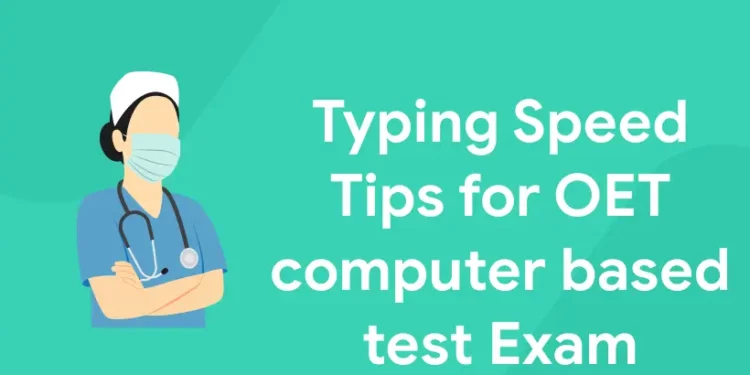Table of Contents
Candidates for the OET now have the option to take the exam on a computer instead of paper by using computer-based OET and OET at Home. While the majority of OET test takers worry about computer-based OET because they can’t type quickly enough, they often forget that typing on a computer is far more prevalent than writing with a pen or pencil these days. In actuality, writing by hand is difficult for most people, while typing is far more versatile and quick.
Get your Desired OET Scores in Weeks! Get a Free Demo Class Here!
Benefits of Typing over Writing in Pen/Pencil in OET
- Compared to having to erase and rewrite in pencil, editing or deleting text on a computer is far simpler.
- A sentence can be moved from one place to another. This could help retain information organisation and increase coherence in the event that you initially typed a sentence in the incorrect place.
- Poor handwriting is no longer a problem for the OET at Home and computer-based exams.
- A significant amount of time is saved by the rapid editing and deletion of content, as opposed to having to erase and rewrite it while taking a paper-based OET.
- The word counter in the OET computer-based writing sub-set keeps track of the words you have typed, allowing you to determine how many more words you need to write in order to satisfy the minimum word-length requirements.
Typing Tips for OET computer based test and OET at Home
1: What is the primary purpose of a patient’s discharge summary?
Listening Part A
Answers to the OET Listening Parts A-1 and A-2 consist of one word or a brief phrase (usually two to three words). These are not difficult to type; the true trick is to do so quickly while keeping up with the audio of the chat. Frequently, applicants begin fumbling with the keyboard’s keys and waste valuable time.
To speed listening in Parts A and B, use the following tips
- Make sure the cursor is already where the blank is so you can begin typing right away.
- Get familiar with the fundamentals of keyboard layout and, if you can, practise typing with typing tutor software. Make yourself at ease using the following keyboard layout if you use a Mac:
- You don’t need to bother about capitalization because small and capital letters are equally appropriate.
- To save valuable time, use the tab tool to move from one blank to the next. Thus, as soon as you have completed writing your response, click the tab key to move the mouse to the next space so that you can begin typing at the proper moment.
- Spelling errors are somewhat allowed, so try not to repair them too much. If you think the answer makes logic, go on to the next question without fixing the spelling.
Reading Part A
Only responses to Questions 8 through 20 must be typed. While the majority of the responses only require one word, some can also call for the drafting of a brief statement with several digits.
Tips for Reading Part A
- Spelling errors are not permitted, in contrast to the listening section. You must thus type the proper spelling.
- The Tab button is functional in OET Reading Part A questions; nevertheless, it is more typical to utilise a mouse to highlight and navigate material while reading. So, using the Tab key might not be the best option.
- Highlighting the term in the text and then typing it is an efficient way to type the response here. It might not work to copy and paste, so be sure you type your response precisely.
- Since Reading Part A only lasts for fifteen minutes, you might not have enough time to go over your responses at the end. Therefore, the best course of action is to type the answer twice before moving on to the following question.
Writing
The only area where you will be typing a lot is the OET Writing Subset.
It should be noted that although the OET Writing Task requires you to write 180–200 words, this is essentially the letter’s body; you also need to write the date, the address, the greeting, and the complimenting conclusion. You would therefore be typing anywhere between 230 and 250 words overall.
According to Wikipedia, the average slowest speed is 23 words per minute, which implies you may type the entire letter in 10-15 minutes and still have time to evaluate it afterward. In practice, candidates write one or two sentences at a time, go over the case notes once more, and formulate sentences in their minds because this is a hypothetical situation. Even so, a slow typing pace wouldn’t prevent you from finishing a letter and having time for a last review.
Tips to speeding up in the letter writing
- Use both hands to practise typing.
- Try to focus as much as you can on the screen and avoid looking down at your hands.
While you can see what you are typing, this helps with accuracy and speed, however it may take some getting used to. - As soon as the writing period begins, write the following: Date, Greetings, Re:, and Complementary Close (Yours honestly / faithfully). By doing this, you may make sure that your letter is finished even if time runs out.
One of the most frequent time management problems encountered by OET test takers is running out of time when composing their final statement and forgetting to add a complementing ending before the invigilator returns the writing sheet. - Writing the thank you statement first and then beginning to compose the introduction is a potentially useful strategy. Some frequent template sentences include: Please contact me for further details.
Please contact us if you require any further information.
Thank you for agreeing to assist with this problem. - Type a lot of OET sample letters to get comfortable and proficient with the keyboard. You will also be able to learn some popular words that you can use in the OET letter as a result.
- Learn the following keyboard shortcuts, such as
Shift+ Left Arrow <) – To select a word or a phrase and overwrite it
Shift + Right Arrow () – To select a word or a phrase and overwrite it
Ctrl + Up Arrow (T) – To jump from existing paragraph/line to the next
one
CTRL + Down Arrow (V) – To jump from existing paragraph/line to the previous one
CTRL + Z – To undo any mistake. For example, if you deleted some text by mistake, you can recover that by simply pressing this key combination.
Entri App – Online OET Coaching
Do you plan to pass the OET exam on your first attempt? Are you looking for a study guide that will allow you to train for a short period of time and achieve the necessary OET score? The knowledgeable instructors at Entri will use individualised, rigorous, and deliberate learning strategies to help you enhance your OET results.
Course Overview
The purpose of the OET Preparation Course on the Entri App is to help healthcare professionals meet the requirements of the Occupational English Test (OET) by helping them to improve their English language proficiency. This comprehensive course covers all four language skills—Listening, Reading, Writing, and Speaking—in great detail, with a focus on the context of healthcare settings to ensure that students are prepared to satisfy the OET criteria.
Get your Desired OET Scores in Weeks! Get a Free Demo Class Here!
Frequently Asked Questions
How is the OET exam on computer?
The Speaking sub-exam is taken via Zoom from your home, while the Reading, Writing, and Listening sub-tests are administered at the test location.
How long does it take to get OET computer-based test results?
The OET computer-based test results are obtained in ten days.
What is the minimum OET Listening score required to earn a grade B?
Although the OET does not offer a precise score, in order to receive a grade B, test takers typically need to answer correctly on at least 30 of the 42 items in the test.











